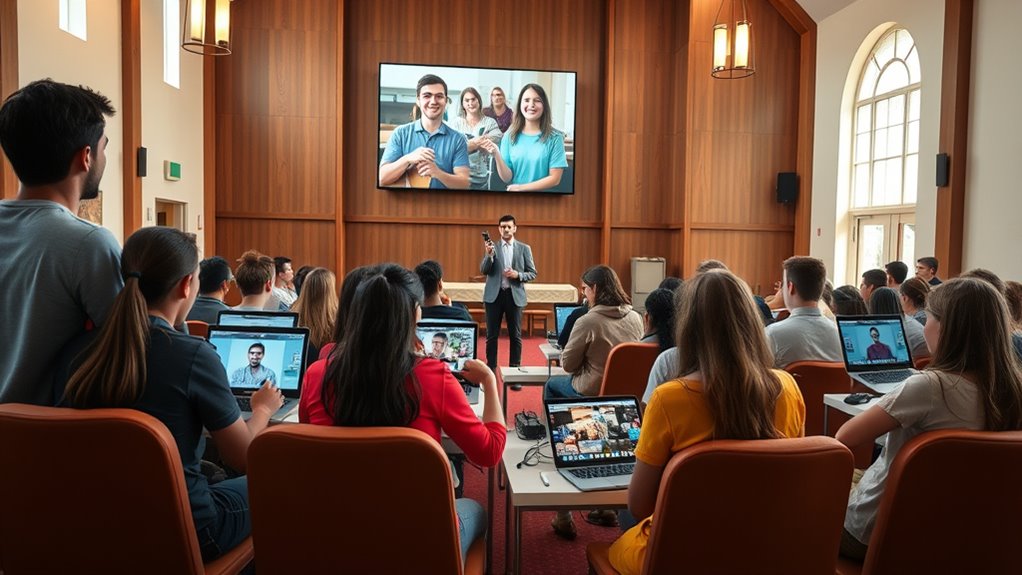Hybrid engagement in youth ministry involves blending online and in-person efforts to create meaningful connections. You can reach young people where they are by using social media, live streams, and virtual events alongside traditional gatherings. This approach helps build authentic relationships, encourages spiritual growth, and keeps your ministry flexible amid changing circumstances. Staying adaptive and relevant guarantees your youth feel connected and supported—if you want practical ideas, keep exploring how to make this work effectively.
Key Takeaways
- Hybrid engagement combines online and in-person activities to create seamless, authentic youth ministry experiences.
- Utilizing digital tools like social media and live streams extends reach and fosters ongoing spiritual growth.
- Coordinating virtual events with local in-person efforts reinforces relationships and faith practices.
- Flexibility allows ministries to adapt quickly to external factors, maintaining vibrancy and relevance.
- Authentic conversations and continuous digital content deepen youth engagement and spiritual development.

In today’s rapidly changing landscape, hybrid engagement has become essential for effective youth ministry. You need to meet young people where they are, both online and offline, to truly connect and foster growth. Virtual outreach is a powerful tool in your arsenal, allowing you to reach youth who might not attend in person or who prefer the comfort of their own space. Through social media, live streams, and interactive online events, you can create meaningful touchpoints that spark curiosity and build relationships. This approach isn’t just about broadcasting messages; it’s about engaging in authentic conversations, listening to their stories, and showing genuine interest in their lives. Digital discipleship becomes the backbone of your ministry, providing ongoing spiritual nourishment that fits into their digital routines. By leveraging online resources, devotionals, and discussion groups, you help young people deepen their faith in ways that are accessible and relevant to them. Incorporating nourishing content that promotes spiritual growth through digital platforms further enhances engagement and encourages ongoing participation.
You should see hybrid engagement as a way to complement your in-person efforts, not replace them. While gathering face-to-face remains crucial for building community and fostering personal connections, integrating digital tools extends your reach and reinforces your message. When you combine in-person events with virtual outreach, you create a seamless experience that meets youth on their digital turf and invites them into your physical space. For example, you might host a weekly Bible study online and then follow up with a local hangout or service project. This consistency helps youth see that faith isn’t confined to the church building but is a part of their everyday lives. It also encourages ongoing digital discipleship, where you can share resources, prayer requests, and encouragement through messaging apps or social media platforms.
Furthermore, embracing hybrid engagement enables you to adapt quickly to changing circumstances, such as health restrictions or weather issues, without losing momentum. It allows you to be flexible and innovative, ensuring that your ministry remains vibrant and accessible. When you prioritize virtual outreach and digital discipleship, you’re not just keeping up with trends—you’re intentionally meeting young people where they are, making faith relevant and approachable. This dual approach empowers you to build deeper relationships, nurture spiritual growth, and create a dynamic community that transcends physical boundaries. Ultimately, hybrid engagement isn’t just a strategy; it’s a crucial way to stay connected, relevant, and effective in a digital age.
Frequently Asked Questions
How Do I Measure the Effectiveness of Hybrid Youth Ministry Programs?
You measure the effectiveness of your hybrid youth ministry programs by gathering participant feedback through surveys and discussions, which reveal their experiences and areas for improvement. Additionally, track engagement metrics like attendance, participation levels, and online interactions to see how involved your youth are both online and in person. Combining these insights helps you understand what’s working well and where to adjust, ensuring your programs resonate and grow.
What Are the Best Tools for Seamless Online and In-Person Engagement?
Ever wonder how to keep your youth engaged seamlessly across platforms? You can use tools like live streaming for real-time connection and interactive polls to encourage participation. Platforms like Zoom or YouTube Live make it easy to switch between online and in-person activities. These tools foster active involvement, making your hybrid ministry more dynamic and inclusive. Are you ready to create a connected, engaging experience that resonates both online and in person?
How Can I Address Diverse Technology Access Among Youth Participants?
You can address device disparities and internet accessibility by offering activities on multiple platforms and formats, like printed materials, phone calls, or low-bandwidth options. Guarantee your online resources are mobile-friendly, and consider providing loaner devices or Wi-Fi hotspots for those with limited access. Regularly check in with youth to understand their tech needs, creating an inclusive environment where everyone can participate fully, regardless of their technology access.
What Strategies Foster Community Building in a Hybrid Environment?
You can foster community in a hybrid environment by encouraging peer mentorship, which helps youth connect and support each other across different settings. Create opportunities for shared experiences through group activities, both online and in person, to build bonds and trust. Use breakout sessions and discussion groups to promote active participation, ensuring everyone feels included. This approach strengthens relationships and cultivates a sense of belonging regardless of how participants join.
How Do I Handle Confidentiality and Safety in Hybrid Youth Activities?
You handle confidentiality and safety by setting clear privacy policies and guaranteeing all participants understand them. Address privacy concerns upfront, especially for online interactions, and use secure platforms to protect personal information. Always have emergency protocols in place, so you’re prepared for any situation. Regularly review safety procedures with your team, and encourage open communication to foster trust and ensure youth feel safe both online and in person.
Conclusion
By blending online and in-person approaches, you create a vibrant tapestry where every thread—virtual or physical—intertwines to form a stronger, more resilient fabric. Think of it as planting seeds in both a digital garden and a community orchard, nurturing growth from different soil but sharing the same sunlight. This hybrid approach fuels connection, allowing your youth ministry to bloom across every space, reaching hearts both near and far, like a garden that thrives in all seasons.










